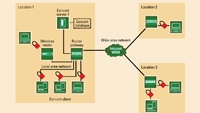Clear-Com's Concert
Network-centric communications have set a new precedent in the way broadcast production teams intercommunicate. The delivery of music, cellular phones, television broadcasts and most forms of media have now transitioned into the IP digital domain.

Voice communication for broadcast and live production is also making the same natural progression into IP, leveraging high-bandwidth and cost-effective private and public networks to extend the communication infrastructure beyond the four walls of broadcast facilities. Voice over Internet Protocol (VoIP) offers many benefits that can complement traditional telephonic communications for intercom applications. Long-distance calls or conference bridges with other production members working in distant facilities are no longer a concern, and the cost of communicating becomes significantly reduced.
Designed with this in mind, Clear-Com's Concert provides a secure, low-latency, software-based intercom system for such applications. The solution changes the production workflow by expanding communication capabilities to remote or extended crew members who traditionally had no access to intercom units from their work locations. The system provides a convenient and seamless communication solution through an Internet-ready device (i.e., desktop computer or laptop) and a high-quality headset, desktop microphone or speaker. (See Figure 1.)
Production members who are away from the traditional hardwired intercoms can remain connected while working in remote locations, such as OB vans, hotels or home offices. Freelance journalists or traveling reporters, for example, can use the solution to talk or text-chat with post-production editors located at headquarters. A team of statisticians can conference in and boil down needed facts to an operator in a live broadcast, while production executives may also conference in on a production without requiring installation of a hardware panel.
Beyond traditional intercoms
The intercom solution offers simpler controls, more flexibility and complete security while providing similar features and functions to many traditional hardware-based intercom systems.
Users can establish point-to-point or group communication efficiently with simple point-and-click controls. An intuitive interface facilitates ad-hoc communications with easy drag-and-drop functionality and makes the user the conductor of his or her own audio conference with the ability to build new conferences, talk groups and private text message exchanges within seconds. Even more compelling for the broadcast user is the fact that its robust architecture allows up to 200 participants and up to 12 sessions to take place simultaneously.
The professional video industry's #1 source for news, trends and product and tech information. Sign up below.
A Presence Awareness detection feature monitors and prompts changes to user availability at any given time. Each user can update his or her own availability status so that other users know, for example, when not to disturb.
Users can initiate text-based communication via a messaging function. Text messaging is a quick way to enter into dialog with other intercom participants without interrupting the existing communication.
With this system, each user has a defined role that determines which conferences or communication channels he or she can access. This means that such functions as technical, security, production and executive can each have their own private conference area as well as admittance to more general conferences.
Under the cover
The system is based on a client/server architecture through the facility's secure server. The client resides on the user's PC, allowing the participation in a conference or ad-hoc person-to-person communication. Servers use a common database in order to ensure that all members can be seen from any client.
Designed for a multiserver environment, extra servers can be added to share the audio routing load or provide additional levels of redundancy as customers' communication needs grow. Each server is capable of supporting thousands of users. The intercom solution operates on a standard IT server running the Linux operating system.
AES 128-bit security is used to encrypt all data (audio and text) within the intercom environment. AES is a block cipher encryption standard that offers highly secure communications without the need to set up complicated virtual private network (VPN) schemes.
Using a unique routing scheme that provides highly efficient, highly scalable audio routing across multiple nodes, the system can grow to support large (potentially thousands) of users without degrading audio quality. In a multisite server environment, for example, each server controls the audio routing within its local area network (LAN) (or wide area if a remote client is logged into that server). This offers the best audio performance in the local network, and only long distance wide area network (WAN) sessions have the added latency of the external telecom network (typically an additional 25ms to 50ms).
Being a VoIP solution, the Concert technology has just scraped the surface of intercom possibilities, while preserving the level of audio quality and extending the user reach of traditional intercoms. More importantly, it drastically changes the dynamics of broadcast productions in unprecedented ways.
Craig Frederickson is the product manager of Concert and all IP communication solutions at Clear-Com Communication Systems.
